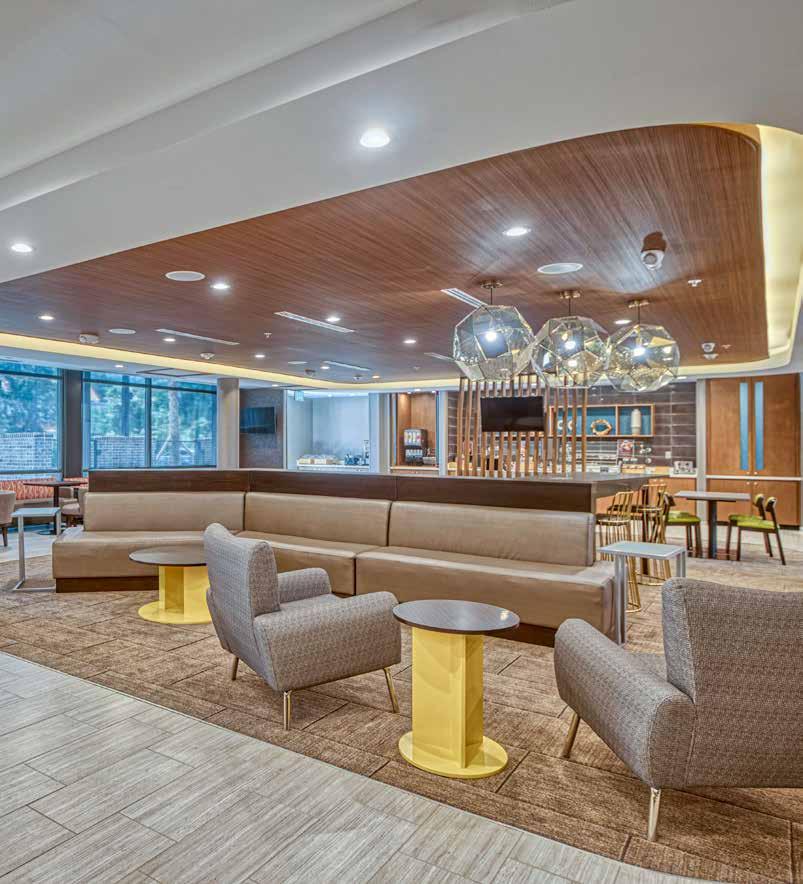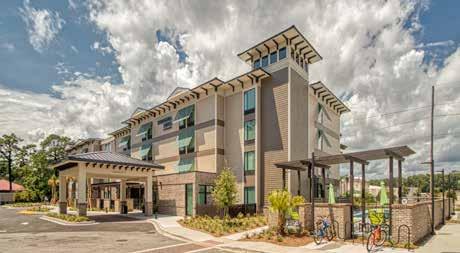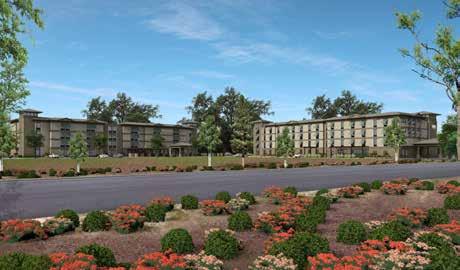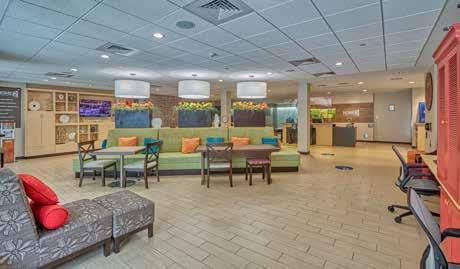
14 minute read
Up for the challenge
from CCR April 21
April 2021
Up for the challenge
The MRP Design Group team was introduced to the owner of a 5.64-acre tract by a mutual friend/contractor with whom they had worked closely for several years in the restaurant business. The owner’s architect recently retired and it just happened that MRP had collectively designed over 100 hotels and so the relationship began.
The project owner, Singh Investment Group, already owned 14 Hilton, Marriott and Holiday Inn products and had the Hilton name on the site with approximately 100 bungalow style, one-story units that were tired and had evolved into extreme extended stay facilities. The owner’s intention was to place two completely different concepts, a Springhill Suites by Marriott and a Home2 by Hilton, on this one tract. MRP worked side-by-side with the civil engineers to craft site plans that creatively managed the usage of the property while maximizing value and profitability for each concept. There were “grandfathered” site conditions that discouraged more robust development until the owner felt the timing was a must. Developing a project on Hilton Head Island (HHI) where “Island Character” transcends all other parameters, provides its own set of challenges but this property had a laundry list of other issues to contend with. The site was below floodplain level, had high voltage transfer lines with a 50-footwide easement, and suffered from extremely low water pressure for fire protection on the proposed four-story building. MRP was also fighting an oppressive height limitation that required every inch of height to be designed with intention. The Home 2 (H2) hotel was the first concept to be designed. In its standard prototype, Hilton allows for Queen-Queen Rooms, but it is not in the base Hilton drawings as the H2 brand specifically targets the business person on-the-go, providing primarily single queen bed suites.

Hospitality in Commercial Construction



Since Hilton Head Island is a family destination, the MRP team suggested a considerable segment of the building be expanded to have two beds. This change added 6 feet to the footprint for a particular block of rooms requiring related structural design modifications. As a bonus, the laundry and the food serving areas below, which are almost too narrow in the prototype, also enjoyed this extra space to operate more efficiently. Many fashionable trends, like community tables in the breakfast area and modern conveniences, like Wi-Fi accessibility (“The Connected Room”), were included in the prototype, and are easily mastered by our engineers. Having designed hundreds of hotels, addressing these trends and requirements comes easy for them, leaving us to accent the differences that make the brand stand-out and concentrate on big picture items like local design restrictions in place to keep this resort area beautiful. Adding conveniences for the traveler is fun, addressing a floodplain can be a much bigger challenge. Obviously, MRP had to raise the finished floor level out of the flood plain, easy enough. But because of the proximity to the coast, we had to incorporate break-away barrier walls to keep the rain out but allow a flood surge in to save the structure during a storm. Underground propane tanks also had to be anchored so they would not float in frequent high water events. Other storm drainage structures, and water pressure shut off valves that had deteriorated over the years had to be discovered with cameras and pressure tests, and corrected before we could proceed. Hotels require sprinklers, and sprinklers require minimum pressure. Maintaining that minimum pressure requires fire pumps, and most of the time very expensive emergency generators to run the pumps. Sure, there are ways to bypass the main disconnect, avoiding the generator, if the power is deemed “Reliable”, which it is not on the island. MRP provided creative alternatives to the Fire Marshal avoiding the extra expense, while keeping the property safe.
Hospitality in Commercial Construction
Speaking of safety, the site is in a very high lightning strike area, which is only exacerbated by the natural lightning rod of the high voltage lines. This was easily addressed with properly placed lightning protection. Lighting levels are required to be very low on Hilton Head Island. So low, designers had to use special parking lot and pool lighting and careful spacing to meet the national code levels, but not exceed the island character parameters.
Project No. 2 up and ready…
The second hotel, a Marriott Springhill Suites (SHS), had many of the same hurdles as the Home 2 project. Both brands focused on their outdoor spaces, fire-pits, and grilling areas, which fit right into the pedestrian atmosphere in HHI. The building ran parallel and much closer to the power lines requiring us to shuffle the swimming pool from behind the building like the prototype, to the end of the building. The required restrooms and other features were shifted to provide a seamless operation. Humidity was another factor that brought extra focus to these projects. Marriott requires the toilet exhaust to be replaced with conditioned air, piped all the way to each room, from the roof, forcing the balance of air by using diminishing duct sizes as you go, with certain back-draft dampers, etc. That ductwork takes up ceiling height that we did not have to spare considering the local height restrictions, requiring flatter/ wider ducts with other challenges. The Home 2 exhaust system is allowed to pump conditioned air into the hall, and have it drawn half the length of the hall and under the doorway, by varying the volume of exhaust in the suites. There is as much art as there is science to balancing infiltration and other factors. While we were building the Springhill Suites project, the H2 had already developed a moisture issue. A faulty Test and Balance Report had missed the fact that the rooftop toilet exhaust shaft fans had not been set as we required on the drawing, causing a negative pressure and sucking in humidity through the outside walls. The fans were adjusted and the moisture cleaned up before it became a serious detriment to the building. You might think, if you exhaust enough humid air out of the building you are good, but you can exhaust too much. The final buildings were so unlike the initial prototypes, with plantation shutters and other beautiful Design Board Review features sprinkled throughout the design, that MRP had to ask two franchisors for special franchisor consideration more than once. In the end, the projects have become flagships for creative alternatives. For example, the H2 prototype “beacon” feature became a more muted lighthouse tower. The trick was giving the local Design Review Board the “feeling” they wanted without losing the hotel branding completely. Hotels are on the way back after the latest downturn, and the industry is poised to meet the demand.

Tom Morgan is Director of Architecture for MRP. Over the past 31-plus years, MRP has completed more than 2,500 projects across the United States. Its team of NCARB certified architects are specialists in the design and development process, from preliminary interior and exterior layout design through detailed permit and construction drawings to construction administration.


606-932-3117 • sales@grafbro.com

The American Jobs plan released on March 31 details the Administration’s transportation infrastructure assets and priorities, including spending on a wide range of assets and incentives that will greatly impact construction and engineering The operations across industries.
Infrastructure Plan

Your guide to where it may go from here
By Joseph Seliga, David Narefsky, Stephanie D. Wagner, Mitchell D. Holzrichter, Philip R. Recht, Andrew Olmem, Jonathan H. Becker & Warren S. Payne
From modernizing roads and bridges to improving waterways and ports, the American Jobs Plan (AJP) is just the beginning of the legislative process to implement infrastructure provisions that would provide investment and funding for critical infrastructure programs.
On March 31, the Administration released its much-anticipated American Jobs Plan, which outlines $2.3 trillion of proposed spending on not only traditional infrastructure programs, but also climate change, housing, drinking water, workforce development, manufacturing, telecommunications and elderly care measures. It also includes a substantial increase in corporate taxes to pay for the proposal.

AJP sets the stage for what is expected to be a robust debate between the Administration and Congress, and within Congress on the details of the legislation to implement the AJP. It is important to understand what the AJP is and is not. First, AJP is a policy proposal that sets forth the Administration’s policy and spending priorities. It is not, however, a legislative proposal (in other words, there is no proposed legislative language) and does not lay out specific policy details. The details will be contained in the legislative text once it is released. Second, it is important to understand that the $2.3 trillion proposed in the AJP is to be phased in over the course of eight years and is spread across both traditional transportation infrastructure (roads, bridges, mass transit, airports, waterways and railroads) and many other areas of infrastructure (including housing, broadband, drinking water and energy). Therefore, while the proposed level of infrastructure spending is significant, the time horizon and the spending across what is a very broadly defined scope of infrastructure should be kept in perspective.
AJP’s infrastructure proposals include spending of approximately $621 billion over the next decade on a wide range of physical assets and transportation-related incentives, with a focus on safety, reliability and resiliency, including the following:
Asset type proposed spending under the AJP
Road and Bridge Modernization — Repairing and modernizing 20,000 miles of highways and roads; fixing the 10 most “economically significant” large bridges as well as repairing 10,000 smaller bridges ($115 billion)
Road Safety — Increasing funding to local “vision zero” plans and safety improvements to reduce accidents ($20 billion) Public Transit — Modernizing and expanding public transit systems to meet use demands, including addressing significant transit repair backlogs ($85 billion)
Passenger and Freight Rail — Repairing Amtrak; investing in the Northeast Corridor; improving existing corridors and connecting new city pairs; supporting grants related to rail safety and efficiency ($80 billion)
Airports — Funding the Airport Improvement Program; spending on FAA asset upgrades and programs supporting terminal renovation and multimodal connections to airports ($25 billion)
Ports and Waterways — Improving inland waterways, coastal ports, land ports of entry, and ferries; mitigating impacts of pollution on communities near ports ($17 billion)
Large Projects With Regional and National Economic Benefits — Accelerating “transformative investments” and dedicating funds to “ambitious projects” that may be too complex for existing funding programs (25 billion)
Addressing Historic Investment Inequities — Reconnecting neighborhoods cut off or divided by prior infrastructure investments; increasing focus on equity in future project development ($20 billion)
Electric Vehicles — Supporting grant and incentive programs for producing 500,000 electric vehicle chargers by 2030; creating rebates and incentives for purchasers; replacing diesel transit vehicles and school buses ($174 billion)
What other policy proposals and investments are included?
The AJP also includes nearly $1.4 trillion in spending for clean water infrastructure, digital and broadband infrastructure, power infrastructure, modernization of schools and early learning facilities, affordable housing resources and veterans hospitals. Additionally, AJP calls for funding increases in research and development infrastructure, climate research initiatives, improvements to American industrial capacity for critical goods, innovation hubs and community revitalization, and worker training programs and for increased access to capital for domestic manufacturers. It also includes $400 billion, 20% of the total, to support increased availability of home care for elderly and disabled people.
How is AJP Paid for?
AJP includes a variety of corporate tax changes that would raise over $15 trillion over 15 years and that the Administration asserts would more than pay for the spending included in the AJP. These are to: > Increase the corporate tax from 21% to 28% > Increase the tax on foreign sourced income to 21%, calculate tax based on a country-by-country basis and eliminate allowance for foreign assets
> Impose a 15% minimum tax on large corporations’ book income > Eliminate tax incentives for foreign-derived intangible income (FDII) > Create new regulations to prevent corporate inversions > Eliminate tax preferences for fossil fuels > Increase funding for the Internal Revenue Service (IRS) to increase tax audits of corporations and otherwise prevent corporate tax evasion.
What opportunities will there be for private investment in infrastructure?
AJP includes few details about policies related to infrastructure investment, including with respect to private investment. Legislation implementing components of AJP could include language that could help facilitate increased private investment in infrastructure, which would increase the overall amount of infrastructure investment through the AJP. These proposals include: > Infrastructure investment incentive grants providing federal grants in connection with infrastructure concessions implemented by state and local governments where proceeds of those concessions are reinvested in infrastructure > Increasing or eliminating the current $15 billion cap on surface transportation private activity bonds (which is planned to be included) > Implementing private activity bond authority for social infrastructure projects > Expanding the federal TIFIA and RRIF financing programs and implementing similar low-interest financing programs in other areas of infrastructure (for example, related to resilience, infrastructure equity, airport infrastructure, social infrastructure and broadband development) > Making changes to facilitate the use of private activity bonds and TIFIA financing and the maintenance of tax-exempt debt related to existing infrastructure assets concessions where proceeds are reinvested in infrastructure
Where do we go from here?
The release of the AJP is just the beginning of the legislative process to pass one or more bills in Congress to implement the plan. While the AJP was presented as a single plan, its enactment into law will likely occur in pieces. Many of the spending provisions will be collected into a single bill that will be passed using reconciliation procedures, which permit certain spending and taxing legislation to be passed without being subject to the Senate’s filibuster.
However, a separate bill still will likely be needed to reauthorize surface transportation programs, which expire on Sept. 30, and other programmatic reforms, which are not eligible for inclusion in reconciliation legislation. The Senate Parliamentarian decides which provisions can be included in reconciliation. The Senate Parliamentarian recently ruled that Senate Democrats could use the budget reconciliation process for a second time to move the infrastructure plan forward as they did with the COVID-19 relief package earlier this year. Under budget reconciliation procedures, Senate Democrats could advance infrastructure legislation with only 50 votes, as opposed to 60 votes, which is the threshold for passage for most bills in the Senate. To pass the infrastructure bill using budget reconciliation, all 50 Senate Democrats will need to be in complete agreement on any legislative text.
What is the time frame?
The plan would be to pass the infrastructure legislature by July 4, but the enactment of AJP unlikely is to occur before Congress’s August recess and more likely to happen in the fall. CCR
Joseph Seliga is co-lead of Mayer Brown’s Government Transactions and Projects & Infrastructure practices (Chicago); David Narefsky is a partner in Mayer Brown’s Government Transactions and Projects & Infrastructure practices (Chicago); Stephanie D. Wagner is a partner in Mayer Brown’s Government Transactions and Projects & Infrastructure practices (Chicago); Mitchell D. Holzrichter is a partner in Mayer Brown’s Government Transactions and Projects & Infrastructure practices (Chicago); Philip R. Recht is the Managing Partner of Mayer Brown’s LA office and co-leader of the firm’s Public Policy, Regulatory & Political Law practice; Andrew Olmem is a partner in Mayer Brown’s DC office and a member of the Public Policy, Regulatory & Political Law practice; Jonathan H. Becker is a partner in Mayer Brown’s DC office and a member of the Public Policy, Regulatory & Political Law practice’; and Warren S. Payne is a senior advisor in Mayer Brown’s DC office and a member of the Tax, Public Policy, Regulatory & Political Law and International Trade practices.
The Administration has indicated that the $115 billion in the AJP for roads, bridges and transit is in addition to the expected renewal of the existing surface transportation program funded by the federal gas tax; the last such renewal, in 2015, provided $305 billion in federal funding over the following five years.








